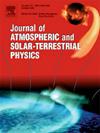俄克拉何马州土壤湿度缩减:采用先进的机器学习
IF 1.8
4区 地球科学
Q3 GEOCHEMISTRY & GEOPHYSICS
Journal of Atmospheric and Solar-Terrestrial Physics
Pub Date : 2025-01-31
DOI:10.1016/j.jastp.2025.106454
引用次数: 0
摘要
本研究采用机器学习降尺度框架,明确利用随机森林(RF)算法,以提高从全球土地数据同化系统(GLDAS)模型获得的土壤湿度数据的空间分辨率,从而从27公里到1公里的分辨率过渡,这显着提高了其在农业应用中的效用。通过整合来自中分辨率成像光谱仪(MODIS)产品的高分辨率预测因子,包括蒸散发(ET)、归一化植被指数(NDVI)、叶面积指数(LAI)和地表温度(LST),以及诸如开放土地地图土壤属性(粘土和沙子组分)、NASA SRTM数字高程模型(30 m)和MODIS土地覆盖分类(MCD12Q1)等补充数据集,本研究有效地实现了GLDAS数据的降尺度。这些方法上的改进为评估农业干旱提供了更精确的土壤湿度估算。为了确保与经验观测结果保持一致,该方法结合了分位数映射(QM)偏差校正,从而提高了GLDAS在俄克拉荷马州六个农业区收集的20多年原位测量数据的准确性。在通过p值分析评估每个预测因子的显著性之后,由于其高p值,增强植被指数(EVI)被省略,表明对土壤湿度估计精度的影响可以忽略不计。通过RMSE(均方根误差)相关系数(CC)和决定系数(R2)等性能指标对降尺度土壤水分估算结果进行了验证,平均RMSE为0.06 (m³/m³),表明降尺度数据与实测数据的一致性。季节分析表明,由于降水模式的一致性,秋季的相关性最高,湿润地区的CC和R2值最大,分别为0.74和0.85;相反,在半湿润和干旱地区,相关性降低,可能是由于灌溉方式的影响和降雨变率的减少。在最后阶段,QM偏置校正的应用进一步减轻了误差,特别是在潮湿地区提高了精度。这些发现强调了缩小GLDAS数据规模并辅以各种辅助数据集对区域干旱监测和农业管理的有效性。这项研究是解决数据限制和支持面临资源限制的农业部门知情决策的可靠资源。本文章由计算机程序翻译,如有差异,请以英文原文为准。
Soil moisture downscaling in the state of Oklahoma: Employing advanced machine learning
This investigation employs a machine learning downscaling framework, explicitly utilizing the Random Forest (RF) algorithm, to enhance the spatial resolution of soil moisture data obtained from the Global Land Data Assimilation System (GLDAS) model, thereby transitioning from a resolution of 27 km–1 km, which significantly increases its utility for agricultural applications. By incorporating high-resolution predictors sourced from Moderate Resolution Imaging Spectroradiometer (MODIS) products, including Evapotranspiration (ET), Normalized Difference Vegetation Index (NDVI), Leaf Area Index (LAI), and Land Surface Temperature (LST), along with supplementary datasets such as Open Land Map Soil attributes (clay and sand fractions), NASA SRTM Digital Elevation Model (30 m), and MODIS land cover classifications (MCD12Q1), this research effectively executes the downscaling of GLDAS data. These methodological enhancements produce more precise soil moisture estimations for assessing agricultural droughts. To ensure alignment with empirical observations, this methodology incorporates Quantile Mapping (QM) bias correction, thereby enhancing the accuracy of the GLDAS data about in-situ measurements gathered over 20 years across six agricultural regions in Oklahoma. Following an evaluation of the significance of each predictor via p-value analysis, the Enhanced Vegetation Index (EVI) was omitted due to its high p-value, indicating a negligible impact on the accuracy of soil moisture estimations. The research validates the downscaled soil moisture estimations through performance metrics, including Root Mean Square Error (RMSE) Correlation Coefficients (CC), and coefficient of determination (R2), resulting in an average RMSE of 0.06 (m³/m³), which signifies concordance between the downscaled data and the observed measurements. Seasonal examination reveals that the highest correlation is observed during autumn, attributed to consistent precipitation patterns, with CC and R2 values reaching a maximum of 0.74 and 0.85 in humid regions; conversely, correlations decrease in semi-humid and arid regions, likely due to the influence of irrigation practices and diminished rainfall variability. In the final phase, the application of QM bias correction further mitigates errors, particularly improving accuracy in humid areas. These findings underscore the effectiveness of downscaled GLDAS data, augmented with various ancillary datasets, for regional drought monitoring and agricultural management. This study is a reliable resource for addressing data limitations and supporting informed decision-making of farming sectors facing resource constraints.
求助全文
通过发布文献求助,成功后即可免费获取论文全文。
去求助
来源期刊

Journal of Atmospheric and Solar-Terrestrial Physics
地学-地球化学与地球物理
CiteScore
4.10
自引率
5.30%
发文量
95
审稿时长
6 months
期刊介绍:
The Journal of Atmospheric and Solar-Terrestrial Physics (JASTP) is an international journal concerned with the inter-disciplinary science of the Earth''s atmospheric and space environment, especially the highly varied and highly variable physical phenomena that occur in this natural laboratory and the processes that couple them.
The journal covers the physical processes operating in the troposphere, stratosphere, mesosphere, thermosphere, ionosphere, magnetosphere, the Sun, interplanetary medium, and heliosphere. Phenomena occurring in other "spheres", solar influences on climate, and supporting laboratory measurements are also considered. The journal deals especially with the coupling between the different regions.
Solar flares, coronal mass ejections, and other energetic events on the Sun create interesting and important perturbations in the near-Earth space environment. The physics of such "space weather" is central to the Journal of Atmospheric and Solar-Terrestrial Physics and the journal welcomes papers that lead in the direction of a predictive understanding of the coupled system. Regarding the upper atmosphere, the subjects of aeronomy, geomagnetism and geoelectricity, auroral phenomena, radio wave propagation, and plasma instabilities, are examples within the broad field of solar-terrestrial physics which emphasise the energy exchange between the solar wind, the magnetospheric and ionospheric plasmas, and the neutral gas. In the lower atmosphere, topics covered range from mesoscale to global scale dynamics, to atmospheric electricity, lightning and its effects, and to anthropogenic changes.
 求助内容:
求助内容: 应助结果提醒方式:
应助结果提醒方式:


